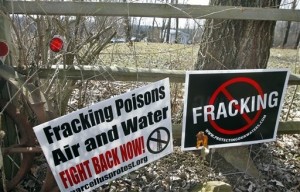By Marco Torres
Guest Writer for Wake Up World
More than 15 million Americans, are now estimated to live within one mile of a natural gas well drilled since 2000. Those numbers are increasing. Researchers report preliminary evidence of an association and statistical significance between two birth defects and a mother’s residential proximity to natural gas wells at the time of birth.
Research has demonstrated that natural gas development results in the emission of pollutants that include suspected developmental toxicants, such as benzene, toluene, and xylenes, although few studies have investigated the public health impact of these emissions.
This number of potentially toxic petroleum hydrocarbons in the air near the wells is staggering. Benzene has been identified by the Environmental Protection Agency as a known carcinogen. Other chemicals included heptane, octane and diethylbenzene but information on their toxicity is limited.
“Studies like this underscore the need for more representative and comprehensive research on workers and communities to understand their exposures and potential health risks,” says Aubrey Miller, a senior medical advisor at the National Institute of Environmental Health Sciences.
“Our data show that it is important to include air pollution in the national dialogue on natural gas development that has focused largely on water exposures to hydraulic fracturing,” said Lisa McKenzie, Ph.D., MPH, lead author of the study and research associate at the Colorado School of Public Health.
Researchers led by Lisa McKenzie at the Colorado School of Public Health estimated exposure to natural gas development for nearly 125,000 Colorado women. They used an “inverse distance weighting” method in which they determined the density of natural gas wells within a 10-mile radius of each mother’s home at the time she gave birth, with greater weighting for wells nearer the home. Then they compared proximity to gas wells between mothers who had adverse birth outcomes–including three types of birth defects, preterm birth, and term low birth weight–and those who did not.
The non-cancer health impacts from air emissions due to natural gas development has been reported as high for many years for residents living closer to wells. The greatest health impact corresponds to the relatively short-term, but high emission, well completion period.
Among 59 cases of neural tube defects, prevalence was twice as high among babies of mothers in the highest exposure group–a group of 19 women with more than 125 wells per mile within a 10-mile radius of the home–compared with babies of unexposed mothers.
Among 1,823 cases of congenital heart defects, prevalence was 30% higher among babies of mothers in the highest exposure group, compared with babies born to unexposed mothers. In contrast to neural tube defects, however, the likelihood of a congenital heart defect increased steadily with increasing exposure. Congenital heart defects are the most common type of birth defect, affecting about 8 of every 1,000 newborns in the United States.
Although low levels of maternal folic acid–a B vitamin found in green leafy vegetables–is an established risk factor for neural tube defects, little is known about other environmental factors that may contribute to these birth defects. Two previous studies suggested that maternal exposure to benzene could increase congenital heart defects and neural tube defects. Another study reported associations between several birth defects in California and increased ambient concentrations of carbon monoxide and ozone.
There is more evidence coming forward that trimethylbenzenes, aliaphatic hydrocarbons, and xylenes, all have neurological and/or respiratory effects.
Typically, wells are developed in stages that include drilling followed by hydraulic fracturing , the high powered injection of water and chemicals into the drilled area to release the gas. After that, there is flowback or the return of fracking and geologic fluids, hydrocarbons and natural gas to the surface. The gas is then collected and sold.
“The study certainly raises legitimate concerns, given that there are plausible mechanisms for many of the chemicals that are used in natural gas development,” says Kenneth Spaeth, medical director of the Occupational and Environmental Medicine Center at North Shore University Hospital inNew York, who was not involved in the study.
VIDEO: GASLAND Trailer 2010
Article Sources:
Previous articles by Marco:
- The 10 Most Addictive Substances – Guess Which One is Not on the List?
- 4 Diseases That Can Be Reversed Naturally Without Pharmaceutical Drugs
- Teens are Not Convinced that Sunscreen Prevents Disease
- Woman Shrinks Inoperable Mass, Heals Her Thyroid Disease With Cannabis Oil
- Playing God: 4 Geoengineering Projects Doomed To Fail While Polluting The Earth
- 5 Big Signs The Global Engine of Deceit, Lies and Control Are Coming To End
- Man Heals His Excruciating Pain With Cannabis After A Battery of Pharmaceuticals Failed
About the author:
Marco Torres is a research specialist, writer and consumer advocate for healthy lifestyles. He holds degrees in Public Health and Environmental Science and is a professional speaker on topics such as disease prevention, environmental toxins and health policy.
This article was reposted with the permission of the kind crew at preventdisease.com

If you've ever found value in our articles, we'd greatly appreciate your support by purchasing Mindful Meditation Techniques for Kids - A Practical Guide for Adults to Empower Kids with the Gift of Inner Peace and Resilience for Life.
In the spirit of mindfulness, we encourage you to choose the paperback version. Delve into its pages away from screen glare and notifications, allowing yourself to fully immerse in the transformative practices within. The physical book enriches the learning process and serves as a tangible commitment to mindfulness, easily shared among family and friends.
Over the past few years, Wake Up World has faced significant online censorship, impacting our financial ability to stay online. Instead of soliciting donations, we're exploring win-win solutions with our readers to remain financially viable. Moving into book publishing, we hope to secure ongoing funds to continue our mission. With over 8,500 articles published in the past 13 years, we are committed to keeping our content free and accessible to everyone, without resorting to a paywall.







